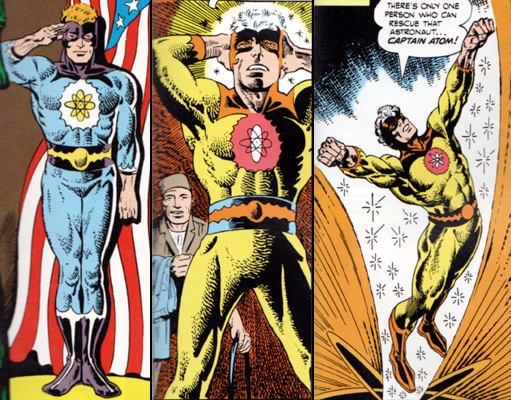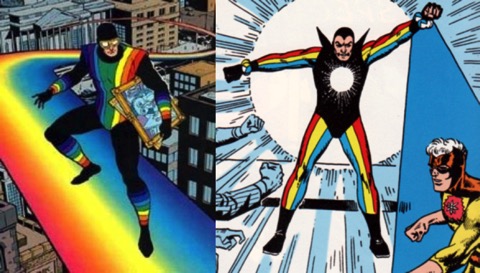Comics
The Costumes of Captain Atom
03/07/10 02:07 PM
As mentioned elsewhere, Captain Atom, published by Charlton Comics, was my childhood hero. The comic is notable in that the artwork was done by Steve Ditko, before he became known for his pioneering work on Marvel's Spider-Man. While I have most of the individual Captain Atom comics, his stories were reprinted in Action Heroes Archive, Volumes 1 and 2.
In his brief run from 1960-61 and 1965-67 there were nine variants of his costume. Here are the first three.

The blue and mauve costume and ginger hair is from his first appearance in Space Adventures #33. It's likely this was a coloring mistake, as his costume is orange and gold on the cover. The next issue shows the familiar orange and gold and the Captain has his trademark silver hair. The blue in the belt lasted one full issue and alternated between blue and black in Space Adventures #35. With Space Adventures #36 the blue was gone for good as typified by the third picture, from Captain Atom #80. The uniform is made from "Diulustel", which contains his radioactivity. Note the pointed boots. Read More...
In his brief run from 1960-61 and 1965-67 there were nine variants of his costume. Here are the first three.

The blue and mauve costume and ginger hair is from his first appearance in Space Adventures #33. It's likely this was a coloring mistake, as his costume is orange and gold on the cover. The next issue shows the familiar orange and gold and the Captain has his trademark silver hair. The blue in the belt lasted one full issue and alternated between blue and black in Space Adventures #35. With Space Adventures #36 the blue was gone for good as typified by the third picture, from Captain Atom #80. The uniform is made from "Diulustel", which contains his radioactivity. Note the pointed boots. Read More...
Comments
Separated At Birth?
03/02/10 07:58 PM
Fark featured a discussion on the 10 most ridiculous costumes in comic books. Someone posted a picture of the Rainbow Raider, a nemesis of the Flash. The Rainbow Raider's costume looked somewhat familiar. Compare the costume of the Raider, who first appeared in 1980, with the costume of Dr. Spectro, an opponent of Captain Atom, who first appeared 14 years earlier in 1966.

Quis custodiet ipsos custodes?
04/12/09 08:29 PM
I did.
With the release of the movie The Watchmen I became interested in understanding the reasons behind the hype. A friend at church loaned me his copy of the graphic novel which I read over the next four days. The artwork was adequate, but not spectacular; the story was well plotted, the characters atypically complex, and the ending was satisfying. My overall reaction was that it was ok but I wasn’t compelled to see the movie.
Part of my reaction was to the sub-plot of the pirate tale. While it was woven well into the main story, it simply didn’t do anything for me. But this was a minor point compared to my indifference to the characters themselves. One of my earliest memories of comic books was reading Captain Atom in Charlton’s Strange Suspense Stories, certainly issue #77 and possibly #76, in 1965 when I was ten. So I have a soft spot in my heart for Captain Atom and, later, Blue Beetle. To a lesser extent I followed The Peacemaker and Judomaster.
The characters in The Watchmen were shadows of the Charlton characters. Dr. Manhattan was Captain Atom recast; Rorschach was The Question; Nite Owl was Blue Beetle; The Comedian was Peacemaker; Ozymandias was Peter Cannon, Thunderbolt; and The Silk Spectre was Nightshade. Dr. Manhattan, being a poor copy, simply soured me on the story. Instead of the atomic man who explored the mysteries of space, the most powerful man in the world was paralyzed by his philosophy. I usually enjoy exploring the effects a worldview has on people, but not with my childhood hero.
But then the superdrive in my Macbook Pro stopped reliably burning dual-layer DVDs. So on a Saturday I took it to the Apple store, they had one part available, and they would try to effect the swap that day. Since they had my laptop, I looked for something to do. So I went to the movie.
I was blown away. The graphic novel came alive. The special effects were spectacular, especially Manhattan’s “fortress of solitude” on Mars. I remember thinking, “Oh, that’s what the comic imagined.” After the fact, it was obvious, and I shouldn’t have missed it when I read the novel; but that doesn’t lessen that moment of awe. I was able to put aside the distortion of my childhood heroes and enjoy the story for itself.
It is a dark movie. The line between “good guys” and “bad guys” is sometimes nonexistent. This is a good thing, since it is true to life, even though we don’t like to admit it. There is graphic, disturbing, violence. There is graphic nudity, both male and female. One character declines to wear any sort of costume to show his disassociation with mere humans. There is graphic sex, voluntary and otherwise. The ending shows the futility of human knowledge. It may have been the author’s intent to show the futility of human existence, that left to ourselves we are doomed to suffering and strife.
But this is an old theme: compare with the book of Ecclesiastes in the Bible. Fortunately, we have not been left to ourselves.
With the release of the movie The Watchmen I became interested in understanding the reasons behind the hype. A friend at church loaned me his copy of the graphic novel which I read over the next four days. The artwork was adequate, but not spectacular; the story was well plotted, the characters atypically complex, and the ending was satisfying. My overall reaction was that it was ok but I wasn’t compelled to see the movie.
Part of my reaction was to the sub-plot of the pirate tale. While it was woven well into the main story, it simply didn’t do anything for me. But this was a minor point compared to my indifference to the characters themselves. One of my earliest memories of comic books was reading Captain Atom in Charlton’s Strange Suspense Stories, certainly issue #77 and possibly #76, in 1965 when I was ten. So I have a soft spot in my heart for Captain Atom and, later, Blue Beetle. To a lesser extent I followed The Peacemaker and Judomaster.
The characters in The Watchmen were shadows of the Charlton characters. Dr. Manhattan was Captain Atom recast; Rorschach was The Question; Nite Owl was Blue Beetle; The Comedian was Peacemaker; Ozymandias was Peter Cannon, Thunderbolt; and The Silk Spectre was Nightshade. Dr. Manhattan, being a poor copy, simply soured me on the story. Instead of the atomic man who explored the mysteries of space, the most powerful man in the world was paralyzed by his philosophy. I usually enjoy exploring the effects a worldview has on people, but not with my childhood hero.
But then the superdrive in my Macbook Pro stopped reliably burning dual-layer DVDs. So on a Saturday I took it to the Apple store, they had one part available, and they would try to effect the swap that day. Since they had my laptop, I looked for something to do. So I went to the movie.
I was blown away. The graphic novel came alive. The special effects were spectacular, especially Manhattan’s “fortress of solitude” on Mars. I remember thinking, “Oh, that’s what the comic imagined.” After the fact, it was obvious, and I shouldn’t have missed it when I read the novel; but that doesn’t lessen that moment of awe. I was able to put aside the distortion of my childhood heroes and enjoy the story for itself.
It is a dark movie. The line between “good guys” and “bad guys” is sometimes nonexistent. This is a good thing, since it is true to life, even though we don’t like to admit it. There is graphic, disturbing, violence. There is graphic nudity, both male and female. One character declines to wear any sort of costume to show his disassociation with mere humans. There is graphic sex, voluntary and otherwise. The ending shows the futility of human knowledge. It may have been the author’s intent to show the futility of human existence, that left to ourselves we are doomed to suffering and strife.
But this is an old theme: compare with the book of Ecclesiastes in the Bible. Fortunately, we have not been left to ourselves.

